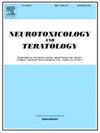Trans-Ferulic acid reduces the sedative activity of diazepam in thiopental sodium-induced sleeping mice: A potential GABAergic transmission
IF 2.8
3区 医学
Q3 NEUROSCIENCES
引用次数: 0
Abstract
trans-Ferulic acid (TFA), a bioactive compound found in many plants, has been recognized for its diverse pharmacological activities, including potential neurological benefits. Previous studies suggest that TFA exerts anxiolytic effects via GABAergic pathways. This study aimed to investigate the sedative effects of TFA and its possible molecular mechanisms through in vivo and in silico approaches. Adult Swiss mice were randomly divided into six groups (n = 7): control (vehicle), standard (DZP: Diazepam at 3 mg/kg, p.o.), three test groups (TFA at 25, 50, and 75 mg/kg, p.o.), and a combination group (TFA: 50 mg/kg with DZP: 3 mg/kg, p.o.). Thirty minutes post-treatment, thiopental sodium (TS) at 40 mg/kg was administered to induce sedation, and latency as well as duration of sleep, were observed for up to 4 h. In silico studies were conducted with GABAA receptor subunits (α1 and β2) to elucidate the possible molecular interactions. The results demonstrated that TFA significantly reduced latency and extended sleep duration in a dose-dependent manner compared to the control. Additionally, TFA combined with DZP further significantly (p < 0.001) enhanced these effects. In silico analysis revealed that TFA and DZP exhibited strong binding affinities with the GABAA receptor subunits (α1 and β2) in the identical binding sites, with binding energies of −6.8 and − 8.7 kcal/mol, respectively. Collectively, TFA exerted a mild sedative effect in TS-induced sleeping mice and modulated the activity of DZP, likely through interactions with GABAA receptors. TFA showed promising activity as a potential candidate for managing sleep disorders such as insomnia.
反式阿魏酸可降低地西泮在硫喷妥钠诱导的睡眠小鼠中的镇静活性:一种潜在的 GABAergic 传导。
反式阿魏酸(TFA)是一种存在于许多植物中的生物活性化合物,它具有多种药理活性,包括对神经系统的潜在益处。以往的研究表明,反式阿魏酸通过 GABA 能途径发挥抗焦虑作用。本研究旨在通过体内和硅学方法研究反式脂肪酸的镇静作用及其可能的分子机制。成年瑞士小鼠被随机分为六组(n = 7):对照组(载体)、标准组(DZP:地西泮,3 mg/kg,p.o.)、三个试验组(TFA,25、50 和 75 mg/kg,p.o.)以及一个联合组(TFA:50 mg/kg 与 DZP:3 mg/kg,p.o.)。治疗后 30 分钟,注射 40 毫克/千克的硫喷妥钠(TS)以诱导镇静,并观察长达 4 小时的睡眠潜伏期和持续时间。对 GABAA 受体亚基(α1 和 β2)进行了硅学研究,以阐明可能的分子相互作用。结果表明,与对照组相比,反式脂肪酸以剂量依赖的方式显著降低了潜伏期并延长了睡眠时间。此外,反式脂肪酸与 DZP 的结合进一步显著(p A 受体亚基(α1 和 β2)在相同结合位点的结合能分别为-6.8 和-8.7 kcal/mol)。总之,TFA 对 TS 诱导的睡眠小鼠具有温和的镇静作用,并调节了 DZP 的活性,这可能是通过与 GABAA 受体的相互作用实现的。反式脂肪酸作为治疗失眠等睡眠障碍的潜在候选药物,表现出了良好的活性。
本文章由计算机程序翻译,如有差异,请以英文原文为准。
求助全文
约1分钟内获得全文
求助全文
来源期刊
CiteScore
5.60
自引率
10.30%
发文量
48
审稿时长
58 days
期刊介绍:
Neurotoxicology and Teratology provides a forum for publishing new information regarding the effects of chemical and physical agents on the developing, adult or aging nervous system. In this context, the fields of neurotoxicology and teratology include studies of agent-induced alterations of nervous system function, with a focus on behavioral outcomes and their underlying physiological and neurochemical mechanisms. The Journal publishes original, peer-reviewed Research Reports of experimental, clinical, and epidemiological studies that address the neurotoxicity and/or functional teratology of pesticides, solvents, heavy metals, nanomaterials, organometals, industrial compounds, mixtures, drugs of abuse, pharmaceuticals, animal and plant toxins, atmospheric reaction products, and physical agents such as radiation and noise. These reports include traditional mammalian neurotoxicology experiments, human studies, studies using non-mammalian animal models, and mechanistic studies in vivo or in vitro. Special Issues, Reviews, Commentaries, Meeting Reports, and Symposium Papers provide timely updates on areas that have reached a critical point of synthesis, on aspects of a scientific field undergoing rapid change, or on areas that present special methodological or interpretive problems. Theoretical Articles address concepts and potential mechanisms underlying actions of agents of interest in the nervous system. The Journal also publishes Brief Communications that concisely describe a new method, technique, apparatus, or experimental result.

 求助内容:
求助内容: 应助结果提醒方式:
应助结果提醒方式:


